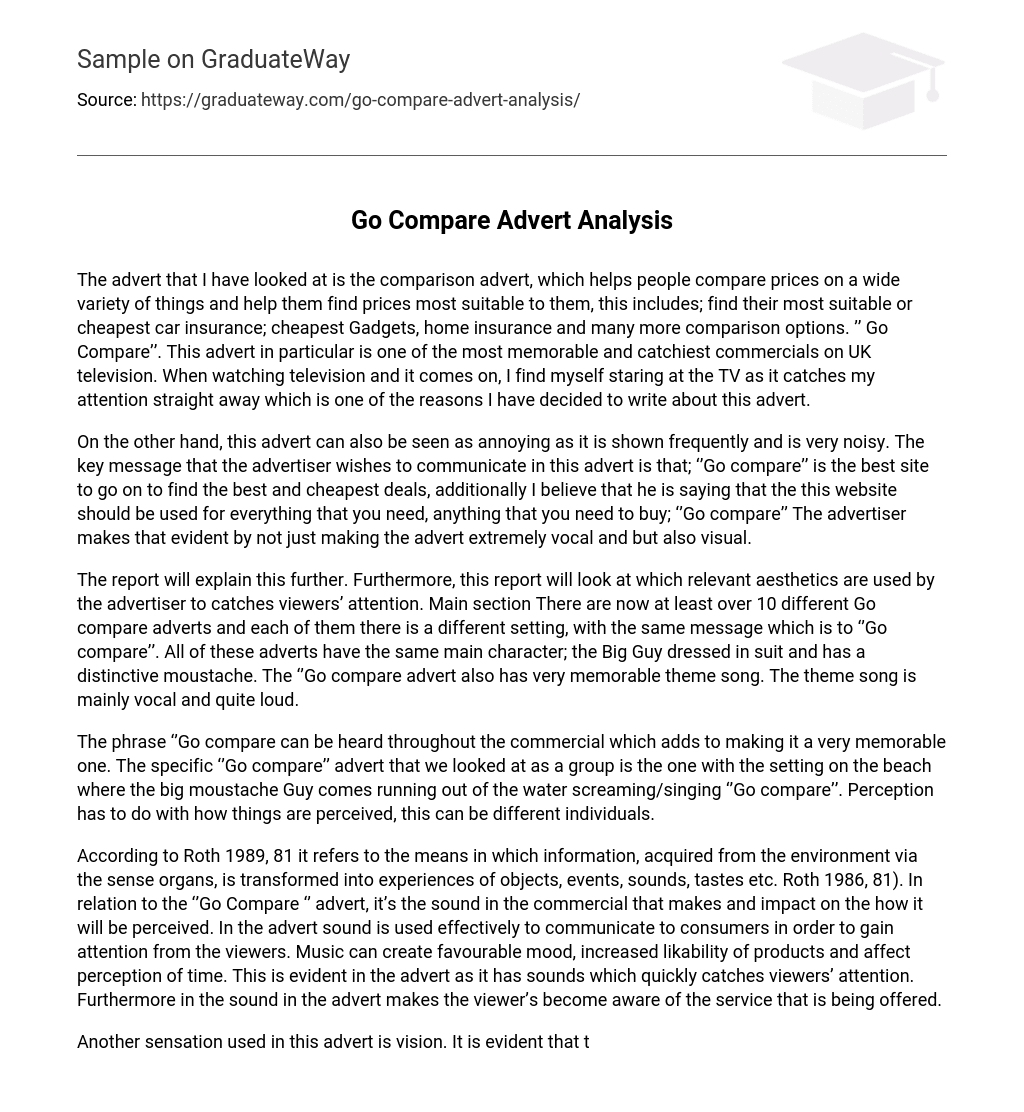The advert I have examined is a comparison advert that assists individuals in comparing prices on various items and finding the most suitable prices for them. This includes comparing car insurance, gadgets, home insurance, and many other options. Known as “Go Compare,” this specific advert is highly memorable and catchy on UK television. Whenever it airs, I find myself captivated by the TV screen as it immediately grabs my attention. This is one of the reasons why I have chosen to write about this advert.
This advertisement can be viewed as both irritating and repetitive due to its frequent appearance and loud volume. However, its main purpose is to convey the message that “Go compare” is the ultimate platform for finding the top-notch and most affordable deals. Furthermore, it emphasizes that this website should be utilized for all purchasing needs. The advertiser effectively communicates this by making the advertisement highly audible and visually engaging.
The report will provide further explanation and also analyze the relevant aesthetics used by the advertiser to capture viewers’ attention.
Main section: There are over 10 different Go compare adverts, each with a different setting but conveying the same message of ‘Go compare’. All of these adverts feature the Big Guy, dressed in a suit and sporting a distinctive mustache. Additionally, the Go compare advert is known for its memorable theme song, which is mainly vocal and loud.
The commercial is very memorable because of the repeated phrase “Go compare” which is heard throughout. The specific advertisement we analyzed as a group features a beach setting where a man with a big mustache comes running out of the water, screaming/singing “Go compare”. Perception relates to how things are perceived, which can vary among individuals.
According to Roth (1989, 81), perception refers to the process in which information obtained from the environment through the sense organs is transformed into experiences of objects, events, sounds, tastes, and more. In the case of the “Go Compare” advertisement, the impact it will have on viewers is influenced by the sound used in the commercial. Effective use of sound in advertising helps in gaining the attention of consumers. Music can create a positive mood, increase likability of products, and influence the perception of time. This is clearly demonstrated in the advertisement as it incorporates attention-grabbing sounds. Additionally, the sound in the advertisement brings attention to the services being offered.
The advert uses visual content to catch viewers’ attention and contribute to the overall sensation. The focus is on capturing attention, as humans have a selective mind and find something to focus on while ignoring everything else around it (Tipper & Driver, 2000). In conclusion, the selected message in the advertisement aligns with the behavioural theory as it incorporates visual, imagination, and sound elements.
The advertisement grabs viewers’ attention immediately by utilizing visualization and sound, aligning with the behavioural theory. Its goal is to captivate its target market and ultimately generate profit. The “Go compare” advertisement is designed to be memorable by incorporating sound, vision, and imagination, all of which stimulate and please consumers’ minds. The advert does not require significant enhancements.
The “Go compare” advert is designed to engage the senses of relevant viewers, including vision and hearing. That’s why it’s so memorable, even just by sound.
Bibliography
Buchanan, D. Huczynski, A (2001). Organisational behaviour Janson-Boyd, C. V. (2010). Consumer Psychology. Maidenhead: Open University Press Solomon, M et al. (2010). Consumer Behaviour – A European Perspective. (4th ed.). Harlow: Prentice Hall. Schiffman, L. G., Kanuk, L. L. & Hansen, H. (2012). Consumer Behaviour – A European Outlook. (2nd ed.). Harlow: Pearson. http://www.youtube.com/watch?v=rvqzx1bA488





